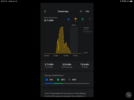I live in the San Francisco Bay Area and had my solar system installed by Tesla back in April. I'm noticing a dramatic drop off in production for the last several months and I'm hoping someone can help me understand if this is normal or if there may be an issue that I need to escalate. I have an 8.16kw Solar Panel system with 2 Powerwalls. Here is some data from my app to help:
I totally understand that the angle of the sun, cloud cover, rain, etc. all will impact production and that I should expect lower production in the Fall/Winter, however this drop off seems far more extreme than what I read about on the web. I was expecting maybe a 50% drop off and not something in the 80-90% range.
I did ask Tesla to look into this and they escalated to Tier 2 support. The response I got back was that the system is "...electrically and mechanically sound. There are no indications of an electrical malfunction and all wires that combine the solar panels are operational. This system is performing optimally at 99% of its bid estimates." Before I drop the issue, I was hoping to hear from others that either my experience is normal or that something doesn't smell right and I should push harder on Tesla to investigate.
Thanks!
| Month | Low (daily) | Avg (daily) | High (daily) |
| July | 34.7 kwh | 46.2 kwh | 50.9 kwh |
| August | 26.0 | 36.7 | 45.3 |
| September | 17.8 | 25.2 | 33.5 |
| October | 6.4 | 12.7 | 17.8 |
| November | 3.9 | 6.7 | 11.9 |
| December | 3.7 | 5.3 | 8.0 |
| January | 1.7 | 5.6 | 9.5 |
I totally understand that the angle of the sun, cloud cover, rain, etc. all will impact production and that I should expect lower production in the Fall/Winter, however this drop off seems far more extreme than what I read about on the web. I was expecting maybe a 50% drop off and not something in the 80-90% range.
I did ask Tesla to look into this and they escalated to Tier 2 support. The response I got back was that the system is "...electrically and mechanically sound. There are no indications of an electrical malfunction and all wires that combine the solar panels are operational. This system is performing optimally at 99% of its bid estimates." Before I drop the issue, I was hoping to hear from others that either my experience is normal or that something doesn't smell right and I should push harder on Tesla to investigate.
Thanks!



